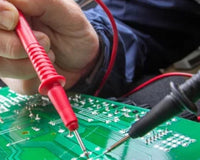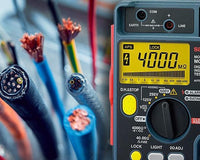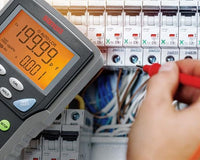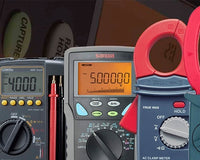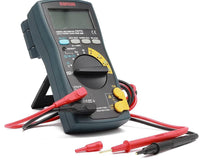 What is an Insulation Tester?
What is an Insulation Tester?See the Full Line of Sanwa Insulation Testers Here
Why do I need an Insulation Tester?
Insulation testers are popular for three main applications:
- Testing the condition or integrity of electrical wires
- Testing the windings of a motor
- Testing electronic devices
The insulation test is performed on conductors to test how resistant they are to current flow and current leakages. A test voltage is applied using the insulation tester across the conductor to measure the amount of current flowing through it, thus proving if the insulation in the conductor is in good condition or not.
For motors, it is necessary to test their winding insulation to make sure environmental factors such as moisture, high humidity, and impurities have not affected the quality of the windings. A test voltage of 500 V to 1000 V is applied across the windings, if the resistance is 10 MΩ or greater than the insulation of the winding is in excellent condition.
Insulation Testers VS Megohmmeters
Though these two devices have similar applications, an Insulation Tester differs from a Megohmmeter in a few key respects. A Megohmmeter is also known as Megger is a device whose sole purpose is to measure the resistances of conductor, motor windings, etc. at higher resistances. A megger will read a wire or motor windings in Megohms, where 1 Megohm is equal to 1,000,000 ohms. In order to read such a high resistance value the meter must be capable of generating a very high voltage.
An Insulation Tester can also be used to measure voltages, perform continuity tests, etc. and offers more features than a Megger. Depending on the model, they can also be used to log data into computers for further analysis.
Types of Tests that can be performed
- Spot Reading Test
The Spot Reading test is the first form of insulation resistance test we'll look at. Simply connect the megohmmeter leads across the insulation to be tested, apply test voltage for a set amount of time (10 mins max), and obtain a resistance measurement. Spot testing is appropriate for systems with a minimal or insignificant capacitance impact, such as a short wiring run.
- Time Resistance Test
The Time Resistance test, commonly known as the dielectric absorption test, is another method for measuring insulation resistance. It entails running a 10-minute test. Measurements are conducted every 10 seconds during the first minute when absorption current has the greatest influence on resistance. Measurements are done once per minute after the first minute.
When you plot the findings, you should observe a curve that begins reasonably quickly and then progressively climbs during the testing time. Moisture, grime, or other causes may be damaging your insulation if the curve is generally flat or begins to drop down as the test goes. This test is best for large rotating electrical machinery.
- Step Voltage Test
The Step Voltage test is a third way. This test is more commonly used in the newer Insulation Testing equipment. It entails comparing the findings of at least two or more test voltages. The test starts with a low beginning test voltage. Measurement is taken at a predetermined time, generally one minute, and then the test voltage is raised. Typically, this rise is five times the original voltage. This procedure can be repeated numerous times, with measurements taking place after one minute and the test voltage increasing at a five-to-one ratio over the preceding voltage.
The Step Voltage test is intended to induce electrical strains on internal insulation fractures, detecting possible faults that would not be disclosed by lower voltage testing. Dry, clean, and in excellent physical condition insulation should yield about the same resistance values over the voltage range.
Safety
Before conducting any insulation resistance test, make sure to follow the safety precautions, as well as any extra requirements provided in the paperwork that came with your test equipment. Insulation resistance testing necessitates the use of high DC voltages. Properly preparing the system under test, as well as the instrument used to conduct the test, is critical to your safety and aids in the prevention of damage to your wiring and machinery.
Once the testing is completed make sure to discharge the capacitance. Sanwa Insulation Testers feature an Auto Discharge function that makes this easy.


